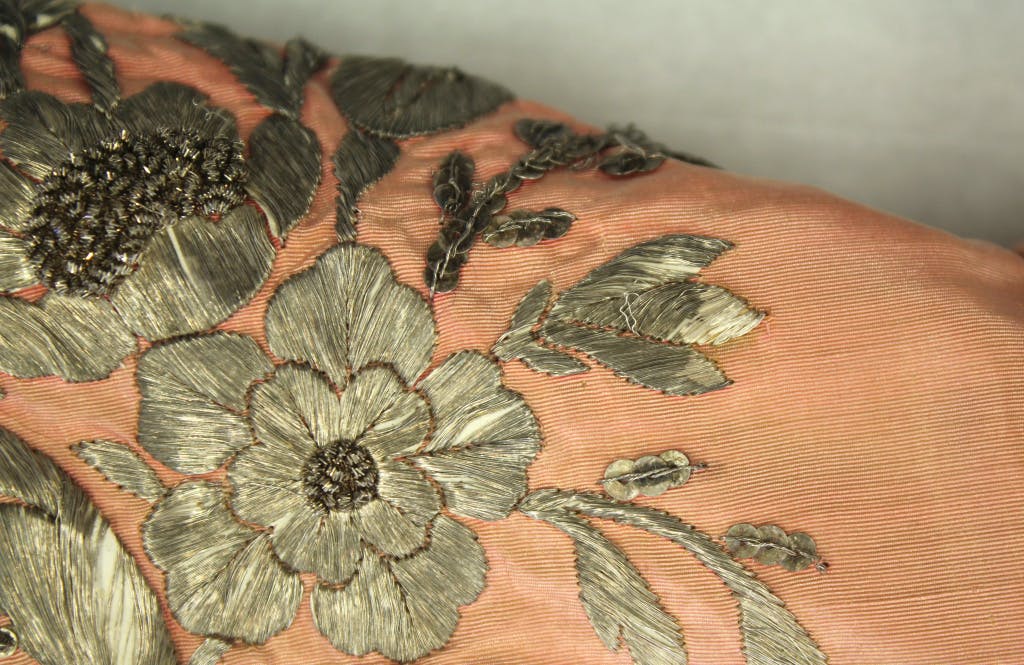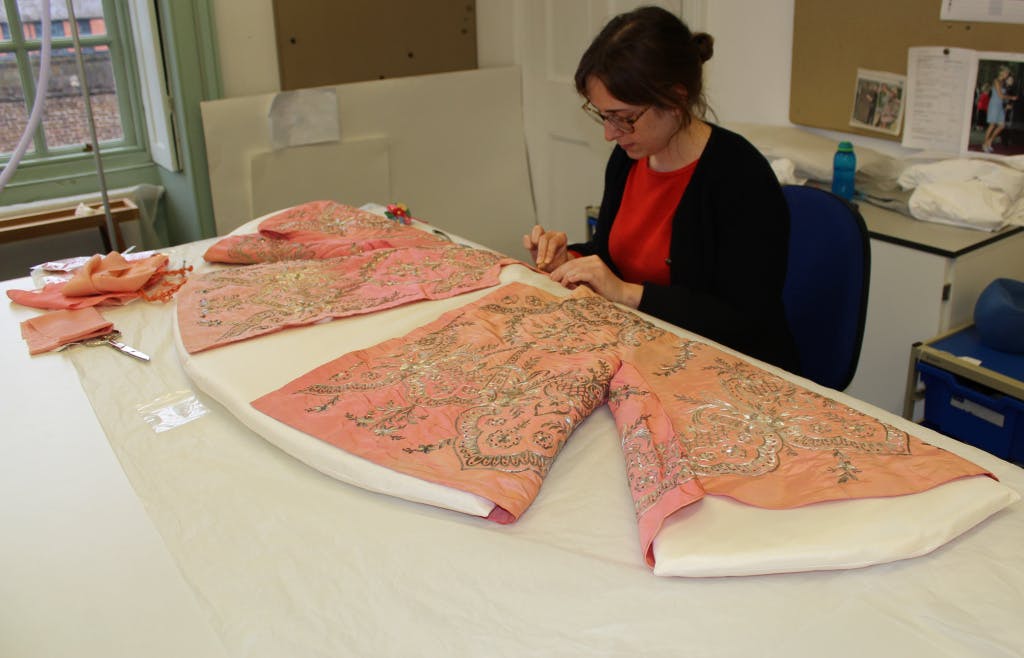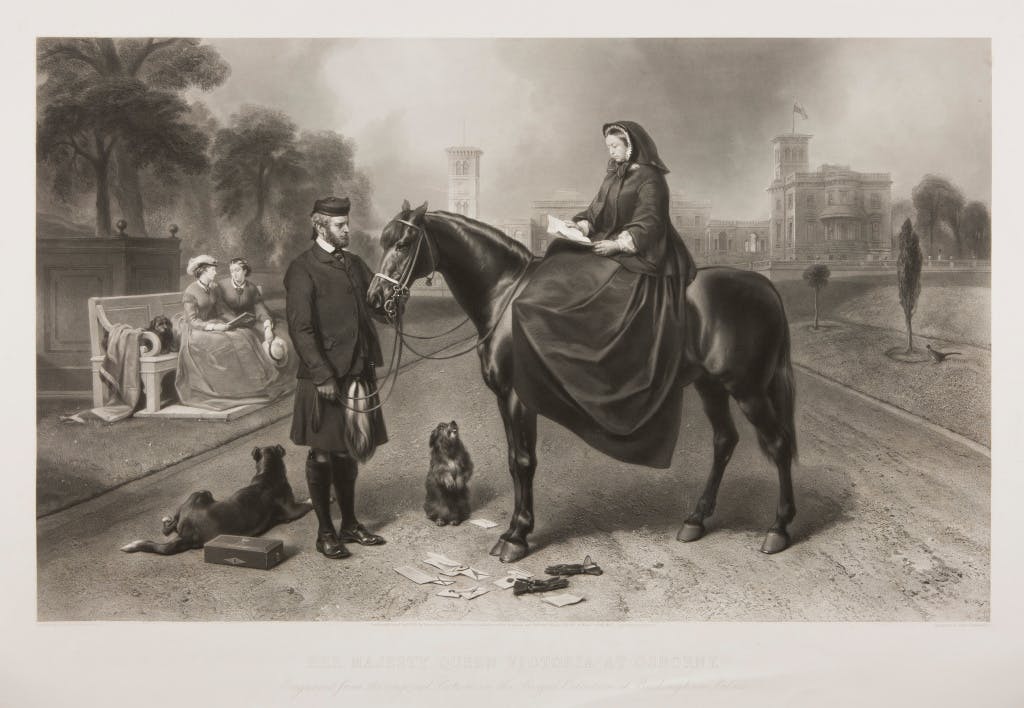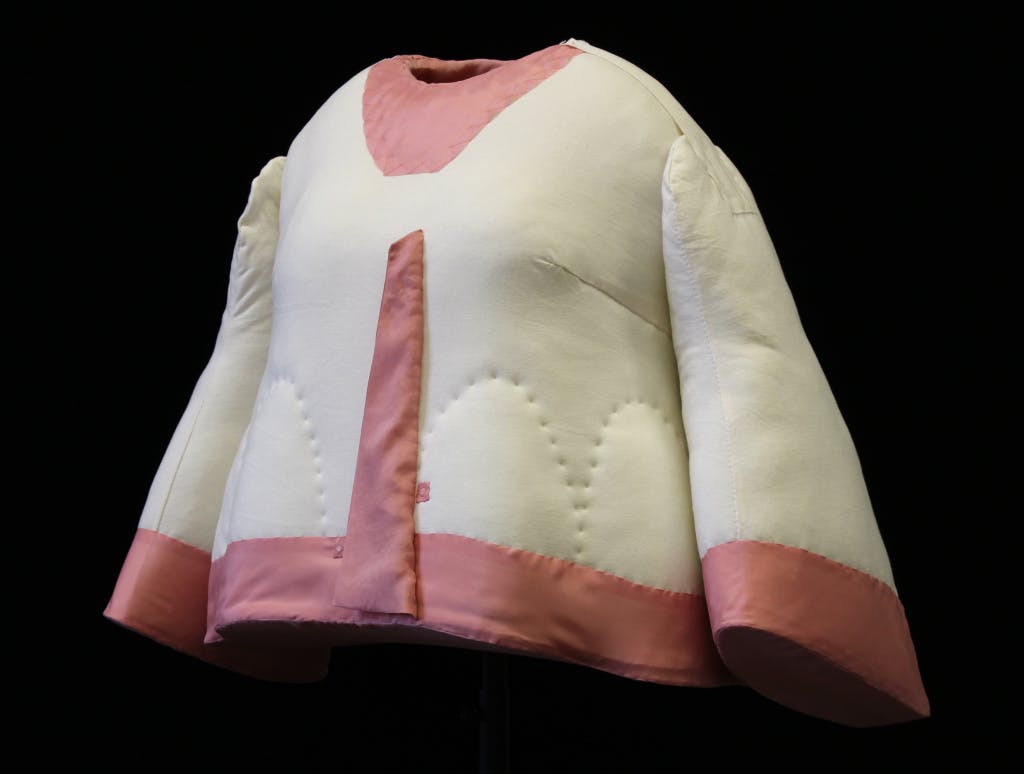Queen Victoria's jacket
Date: 21 December 2018
Author:
Beatrice Farmer
This beautiful pink embroidered jacket was once owned by Queen Victoria and is now in the Royal Ceremonial Dress Collection. The jacket is Ottoman in origin and made of pink moiré silk embroidered with silver.
Take a look behind the scenes with Textile Conservator Beatrice Farmer at the work involved in preparing this magnificent object for display.
How did Queen Victoria come to own this bright pink jacket during her mourning for Albert?
The jacket was a gift to Queen Victoria and was surely a pink, sparkly confection designed to impress. It is thought to have been brought back by her son Bertie, the future Edward VII, from a trip to Constantinople where he met the Ottoman Sultan. This was during her mourning period for Prince Albert when she only wore black, so it is unlikely that she ever wore it, although I like to think she couldn't help but try it on!
The fine silver wire embroidery shows the impressive skill of the Ottoman embroiderers, and the floral motifs and cut of the jacket were the height of fashion in Britain in the late 1860s; this jacket is a striking fusion of two cultures.
Dyes fade and silver tarnishes, but not usually in stripes!
Both the dye fading and silver tarnishing have occurred unevenly, in bands. Some areas are still bright pink and in others the silver continues to shine. The dyes have faded to produce an almost ombre effect due to strong sunlight only reaching certain parts of the jacket. We have concluded that as well as being displayed in a sunny room, during its life it may also have been folded and wrapped in a woollen blanket. The sulphur contained within the molecular structure of wool reacts with silver and causes oxidation, seen as dark grey tarnishing. In a couple of areas this was very pronounced, with noticeable stripes on the embroidery.
Cleaning and repairs
The most tarnished areas of silver embroidery were cleaned with a cosmetic sponge, a somewhat unusual but excellent conservation tool. This helped to bring the shine back a little. The area that has suffered most due to strain and light damage is around the neckline, where there are many small splits in the silk. These have been supported by inserting new silk patches underneath, dyed in-house to match the original. The splits were strengthened using laid thread couching stitches with new silk monofilament thread. In the worst area a fine nylon net has been applied on top to further protect the weak original silk. This has given the jacket enough strength for display on a mannequin.
Finding the accurate historical source
When we started thinking about creating the mannequin form, Curator Claudia Williams came armed with lots of photos of Victoria wearing similar jackets at around this period, such as this 1866 image of her on horseback. The cut of the jacket, without any darts or pleats to provide tailoring, was designed to be worn with quite a loose fit. It was clear the voluminous skirts of the late 1860s would have held the jacket out considerably and also created undulations rather than a smooth outline. At the same time I needed to support the jacket and prevent creases - after all the silk is 150 years old and much more fragile now. This was going to be tricky.
Making the mannequin
We use cutaway acrylic mannequins in our displays. Hopefully the mannequin itself is not distracting and all our visitors notice is the beauty of the jacket itself. The materials are completely inert which means they don't produce any acid that could seep into our precious objects. My colleague Isobel Harcourt made a toile, a perfect copy of the jacket in calico, which was invaluable to use for fittings to avoid handling the real jacket.
This mannequin had an extra Fosshape® skirt and base added for support. Fosshape® is a fabric that can be hardened with heat and steam, in this case an industrial steamer and a pair of hair straighteners. The mannequin was lined in pink silk (intended to look like the lining of the jacket) and the smooth acrylic was covered with calico so that I could stitch padding on. This was mainly done with polyester wadding, built up to the desired shape and covered, so that no fibres shed onto the object.
The arms were a difficult part to get right and do not look like arms at all, but paddles designed to give the impression of arms inside the jacket. They are doing an important job in preventing creases forming in the sleeves which would lead to splits and holes. I used pink silk to cover all of the areas that can be seen on display, like the neckline, base and cuffs. The mannequin was then finished off with magnets to hold the front in place and a silk triangle to stop the front panels touching where they overlap. The time-lapse video shows the main aspects of quite a time-consuming process.
Beatrice Farmer
Senior Textile Conservator
Watch Queen Victoria's Jacket Timelapse
This beautiful pink embroidered jacket was once owned by Queen Victoria and is currently on display at Kensington Palace as part of Victoria Revealed. See how our textile conservation team prepare this magnificent object for display in our film.
This content is hosted on YouTube
This content may be using cookies and other technologies for which we need your consent before loading. To view the content, you need to enable cookies for "Targeting Cookies & Other Technologies".
Manage CookiesMore from our blog

Little Vickelchen': sketches of Queen Victoria as a girl
26 May 2019
A unique set of sketches in our collection show Princess Victoria at three years old, on holiday in the seaside town of Ramsgate, Kent in 1822. They give us a rare informal glimpse of Victoria as a pink-cheeked cherub and a bundle of energy.

Victorian plants are brought to Kensington Palace
08 August 2019
At Kensington Palace we have selected just a few of our favourite discoveries from the Victorian period to go on display in 2019. Each plant has a story and can be accredited to a plant hunter who explored the world during this fascinating period of horticultural research and discovery.

Prince Albert of Saxe-Coburg-Gotha: Monarchy's moderniser
26 August 2019
On the 200th birthday of Prince Albert of Saxe-Coburg-Gotha, Professor John R Davis argues that Albert's influence helped Queen Victoria rescue the British Monarchy.




